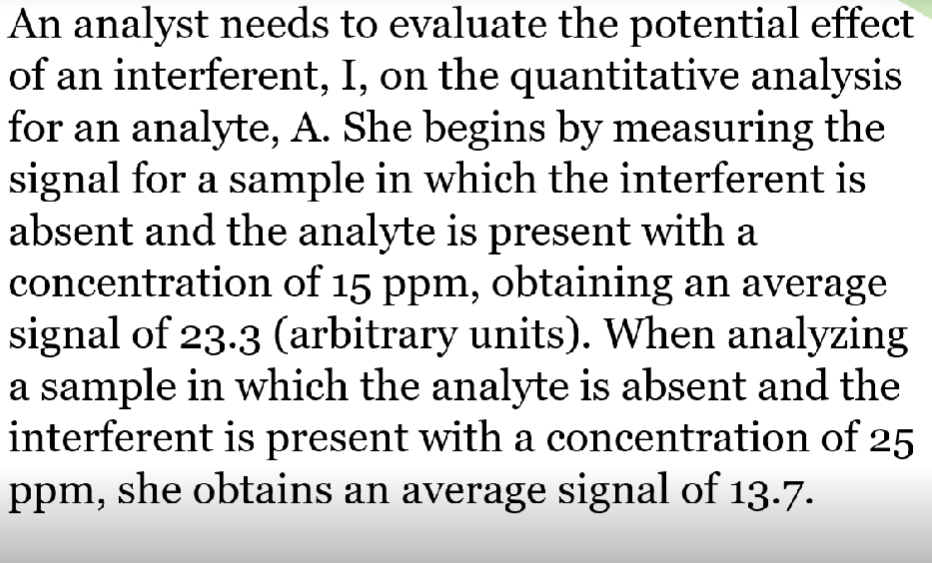An analyst needs to evaluate the potential effect of an interferent, I, on the quantitative analysis for an analyte, A. She begins by measuring the signal for a sample in which the interferent is absent and the analyte is present with a concentration of 15 ppm, obtaining an average signal of 23.3 (arbitrary units). When analyzing a sample in which the analyte is absent and the interferent is present with a concentration of 25 ppm, she obtains an average signal of 13-7.
An analyst needs to evaluate the potential effect of an interferent, I, on the quantitative analysis for an analyte, A. She begins by measuring the signal for a sample in which the interferent is absent and the analyte is present with a concentration of 15 ppm, obtaining an average signal of 23.3 (arbitrary units). When analyzing a sample in which the analyte is absent and the interferent is present with a concentration of 25 ppm, she obtains an average signal of 13-7.
Chapter6: Random Errors In Chemical Analysis
Section: Chapter Questions
Problem 6.17QAP
Related questions
Question

Transcribed Image Text:An analyst needs to evaluate the potential effect
of an interferent, I, on the quantitative analysis
for an analyte, A. She begins by measuring the
signal for a sample in which the interferent is
absent and the analyte is present with a
concentration of 15 ppm, obtaining an average
signal of 23.3 (arbitrary units). When analyzing
a sample in which the analyte is absent and the
interferent is present with a concentration of 25
ppm, she obtains an average signal of 13.7.
![Solve the following problems
a. What is the analyte's sensitivity?
b. What is the interferent's sensitivity?
c. What is the value of the selectivity coefficient?
d. Is the method more selective for the analyte or
the interferent?
e. What is the maximum concentration of
interferent relative to that of the analyte (i.e.,
[interferent]/[analyte]), if the error in the
analysis is to be less than 1%?](/v2/_next/image?url=https%3A%2F%2Fcontent.bartleby.com%2Fqna-images%2Fquestion%2F96490be2-0546-43a7-898e-fe2502cf3946%2F8d6a8a7f-771d-472d-b745-24b48e98c2d3%2F49ty4dm_processed.png&w=3840&q=75)
Transcribed Image Text:Solve the following problems
a. What is the analyte's sensitivity?
b. What is the interferent's sensitivity?
c. What is the value of the selectivity coefficient?
d. Is the method more selective for the analyte or
the interferent?
e. What is the maximum concentration of
interferent relative to that of the analyte (i.e.,
[interferent]/[analyte]), if the error in the
analysis is to be less than 1%?
Expert Solution
This question has been solved!
Explore an expertly crafted, step-by-step solution for a thorough understanding of key concepts.
This is a popular solution!
Trending now
This is a popular solution!
Step by step
Solved in 4 steps

Knowledge Booster
Learn more about
Need a deep-dive on the concept behind this application? Look no further. Learn more about this topic, chemistry and related others by exploring similar questions and additional content below.Recommended textbooks for you


Principles of Instrumental Analysis
Chemistry
ISBN:
9781305577213
Author:
Douglas A. Skoog, F. James Holler, Stanley R. Crouch
Publisher:
Cengage Learning



Principles of Instrumental Analysis
Chemistry
ISBN:
9781305577213
Author:
Douglas A. Skoog, F. James Holler, Stanley R. Crouch
Publisher:
Cengage Learning


EBK A SMALL SCALE APPROACH TO ORGANIC L
Chemistry
ISBN:
9781305446021
Author:
Lampman
Publisher:
CENGAGE LEARNING - CONSIGNMENT